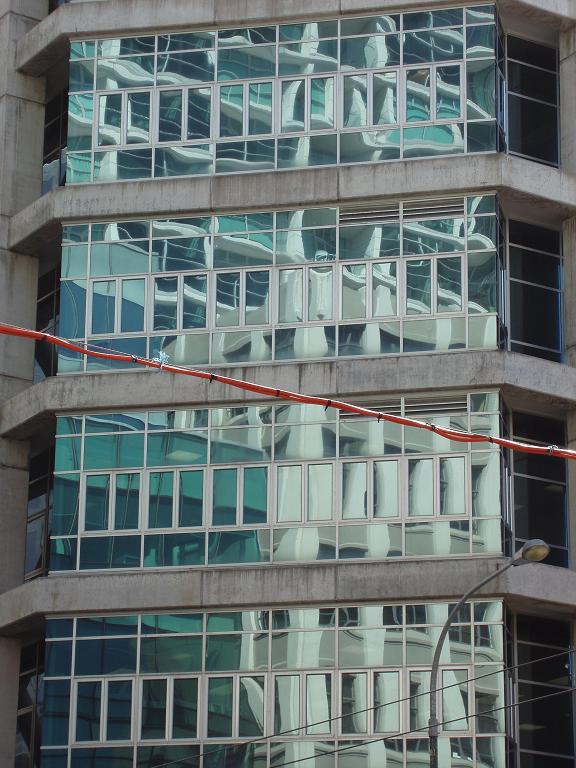City Life is an apartment hotel
on Wellington’s Lambton Quay.
The yellow-leafed tree is
a ginkgo biloba.
I know nothing at all about
the white splotches on the wall.
Between January and April 2015, Bond Street [in Wellington, New Zealand] was transformed with temporary changes to the way the street looked and was used to bring colour and energy to the area.
Bond Street is an important street for servicing local businesses, we wanted to make it a destination for pedestrians as well. To explore ways of making it work for both people on foot and businesses, temporary changes were made to the layout and use of the street before looking at possible long-term changes.
To catch people’s attention and bring vibrancy to the street, two outdoor seating areas and an artificial lawn area were installed. The road surface was painted with a bright red pattern and a shipping container was located on the site to host events. Urban designers call this type of project ‘Tactical Urbanism’ and there are many successful examples of these projects internationally and locally.
Can we? — quickly now!
— Can we just keep pretending
that nothing happened?
(07 May 2016)
The text here is something plucked indiscriminately, unresisted, out of my subconscious. “Reality is … a sum of all texts in various media, including action and thought” (Annette Lavers. 1982. Roland Barthes : Structuralism and After. London: Methuen & Co. [p171].
To me, there’s always been something vaguely sinister about Wellington’s Opera House Lane. That feeling was pretty strong when I was walking through last Wednesday. But it wasn’t the tagging and graffiti grabbing my attention.
The sculptural bulk of the structure overhead – it must be a walkway, I think – the weathered brickwork, and the qualities of the light combined to make it more than usually impressive. And my camera thought so, too.
So here are my three shots. (Oh! you might notice there’s a bit of a photo-shoot happening in #607, by the way.)
This brief post intends to signal that posting to |A Twisted Pair| has recommenced.
It seems not much has changed since then. My last post, on Christmas Eve 2015, carried “an uncommonly handsome view of the Central Police Station – a strong contender, I reckon, for the title of Wellington’s ugliest building.”
Less than a fortnight ago, I posted an image on my Facebook page under the title, REFLECTING ON POLICE BRUTALITY, as follows:
To my eye, the Wellington Central Police Station is one of the ugliest buildings in the city. Upon reflection (in the surfaces of the building on the opposite side of Victoria Street), it does seem more interesting. This image dates from 19 March 2016.
“Brutalist architecture is a movement in architecture that flourished from the 1950s to the mid-1970s, descending from the modernist architectural movement of the early 20th century. The term originates from the French word for “raw” in the term used by Le Corbusier to describe his choice of material béton brut (raw concrete). British architectural critic Reyner Banham adapted the term into “brutalism” (originally “New Brutalism”) to identify the emerging style.”

thin red line (23 December 2015)
“You like buildings, do you?” A mature female voice is addressing me.
I am in Victoria Street, and about to click the shutter on this image, an uncommonly handsome view of the Central Police Station – a strong contender, I reckon, for the title of Wellington’s ugliest building.
Standing at my right shoulder, the speaker is clad in a striking mauve jumpsuit. Jauntily perched on her head is a smart little summer hat. She is not someone I know.
I smile as she wishes me the compliments of the season.
“I like anything that catches my eye,” I tell her. “So be careful.”
The clock ticks three times as she registers what has been said. And then both her thumbs go up. “Nice one!” she declares.
Click on this link to read more: A photographer edits out our smartphones to show our strange and lonely new world
Architect Ian Athfield died on 16 January this year. In the New Zealand Listener (dated the day before), Diana Wichtel presented an engaging interview, first published in the Listener in 2012, in which Ath “talked about starting his landmark ‘act of defiance’ in 1965, and finally wanting to finish the place.” Interview: Architect Ian Athfield
My image shows an advertisement for Havana Coffee. The green Telecom Building peeping in at the top corner of the image, was, according to one NCEA student, “built in a boom period when New Zealanders had big ideas and wanted their cities to look like international ones …”